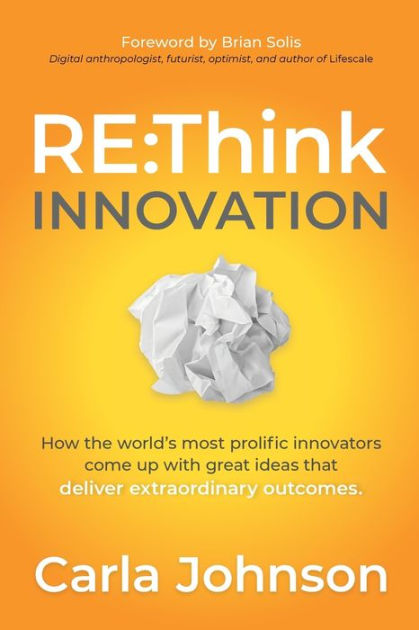There are a lot of reasons why I hesitate to recommend RE:Think Innovation, a new book out this week by my friend Carla Johnson—despite the fact that Carla is one of the warmest, smartest, best-loved people I know.
This is Carla, inside and out:

And this is her new book:

Let me list the reasons you should not buy this book, to get them out of the way:
1. Most new ideas are dumb, and many are dangerous. In her introduction, Carla says it’s her goal “to personally teach one million people how to become innovators by 2025.” Goddamn, I hope she chooses those people carefully.
2. Writing a book to help more people have bright ideas is, as the old Onion headline read, “an inelegant solution to a problem that doesn’t exist.” What we need more than shiny new notions is deep old wisdom, it seems to me. As Carla herself acknowledges (and she acknowledges a lot in this book because she has a lot of deep old wisdom herself), the lack of ideas is not usually what blocks innovation. Fear is. “New ideas are scary, unpredictable and a threat to the status quo,” she writes. “And, let’s face it, given the choice between maintaining the status quo and having the courage to stick your neck out and try something new, you’ll take the first route.” Especially in the utterly conformist and fear-filled corporate culture that Carla writes, will “teach the innovation out of you.”
3. The book offers “a simple five-step framework” that can help people “consistently come up with great ideas.” Most of the innovation that I respect is that which comes from years of studying a single problem. (Carla is a marketer, and I am a tortoise.)
4. The book deemphasizes genius as a factor in idea-making. But we need some Beethovens and Einsteins, too. STAT.
5. I gag on the language of innovation, where yesterday’s “outside the box” and “coloring outside the lines” become today’s “connect the dots,” a phrase I loathe because it sounds easy and not particularly creative. If innovation is just a page full of dots to be connected, why do we need books to tell us how?
6. A book on how to become an innovator seems to me like a book on how to become an athlete. I’m wanting something a little more specific—like how to become a baseball player or a golfer. Or a creative, gutsy, willful leadership communicator with ideas good enough to convince scared bosses to take a few chances too.
So why do I still suggest that maybe you should buy this book? Because as my communicator friend Charlene Wheeless said yesterday, “A dead battery cannot jump a dead battery.” And I sense that a lot of communicators’ batteries are dead right about now.
Do I believe that sitting on a beach somewhere and learning Carla Johnson’s five-step process for innovation —and meanwhile, ruminating about the excitement of actually creating new ideas, and remembering ideas you used to have—is exactly the best thing you can do to get to thinking about new punch combinations after a long career in the ring and a year and a half on the ropes?
Maybe not.
But right now, I can’t think of a better idea.
Can you?
Leave a Reply